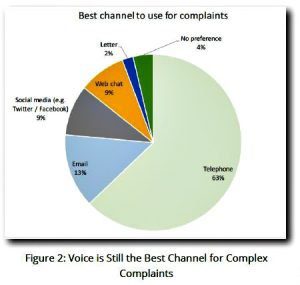The Royal Bank of Canada (RBC) recently produced a whitepaper on the top ten trends shaping the future of the contact center. RBC is among the world’s largest banks with over 80,000 employees. Not surprisingly, Omni-Channel Communications is listed as #1 on the list. Here’s their take:
1. Omni-Channel Communications (in a Multi-Channel World)
As call centers expand their multi-channel offerings, making cross-channel experiences seamless will be more important. The ability to escalate from channel-to-channel was once a luxury, however today’s customers demand nothing less. Surprisingly, though, only 36% of contact centers can track a customer journey that spans multiple channels, and only 17% can locate problem hotspots that impact the customer experience. This is a major concern for most contact centers, as customer expectations are only going to increase. By 2020, the demand for omni-channel support will be amplified by the need for a nearly perfect execution.
The image below, from the ‘Inner Circle Guide to Omni-Channel Customer Contact’ by ContactBabel, reveals the current state of multi-channel, multi-modal, and omni-channel offerings by contact centers.

It’s clear that most contact centers have adopted multi-channel, however only an average of 12% describe themselves as omni-channel.
For a contact center to be truly omni-channel enabled, all applications must be able to seamlessly identify, route, and switch interactions between agents and channels, while keeping all relevant data intact. Given this massive undertaking, it’s quite likely that many organizations are currently in the process of doing just this, and are simply not accounted for in the most recent surveys.
One thing is for certain: The leap toward omni-channel will be a big one, and it should happen in the very near future.
At ATC, we see omni-channel as a natural extension of Unified Communications as a Service (UCaaS). UCaaS allows interaction in just about any way imaginable. It incorporates contact center capabilities while creating omni-channel customer experiences. We mention this in a recent “NEXT GEN Technology” article here.
Check out number 3 on RBC’s list:
3. ‘Hello?’ Is it the Voice Channel You’re Looking for?
For many years, telecom marketers have predicted that the voice channel would eventually fall by the wayside of its digital predecessors. Although customers are using more channels besides voice, many of those interactions often still end up on the voice channel. The truth is that although channel diversity is needed for speedy communications, the telephone still remains an important avenue for solving complex issues.
ContactBabel surveyed 221 contact center managers and found that 63% of the time, they believe the telephone is still the best method of communication for complaints. Although digital channels are growing in popularity, the phone still handles 57.7% of interactions.

So, how can contact centers provide the highest degree of care on the voice channel? Two key elements are needed:
- Training: Proper, consistent, and ongoing training will help to ensure that voice interactions are met with quality and precision.
- Technology: Hold times have always created a concern for customers using the voice channel and must be eliminated at all costs. Cloud call-back solutions like Fonolo have been around for a number of years, but many call centers are still unsure if it’s the right fit for their business.
Tip: If your contact center cares about the customer experience, wants to reduce abandon rates, and decrease telco costs, then a cloud call-back option is a must-have solution for 2017.
Here’s a sneak peak at the entire list of trends outlined in RBC’s whitepaper titled, “Top 10 Trends Shaping the Future of the Contact Center.”
- Omni-Channel Communications (in a Multi-Channel World)
- Go Digital or Go Home
- ‘Hello?’ Is it the Voice Channel You’re Looking for?
- Measure Your Performance and You’ll Go Far
- Social Media − a Not-So-Secret Weapon
- Do-it-Yourself as a Solution
- It’s a Bird, it’s a Plane… No it’s the Cloud
- Reality and Science Fiction Will Begin to Blend
- Get to Know Your Customers
- With Great Data Comes Great Responsibility









